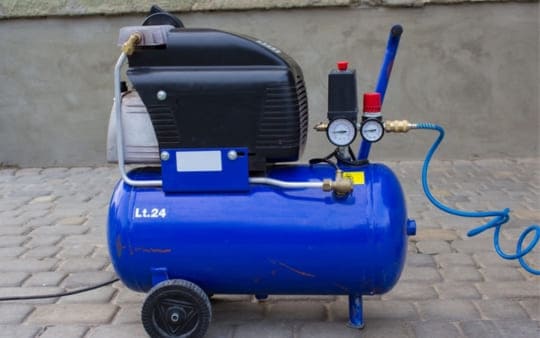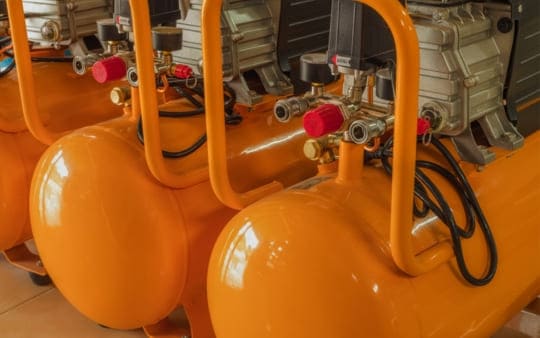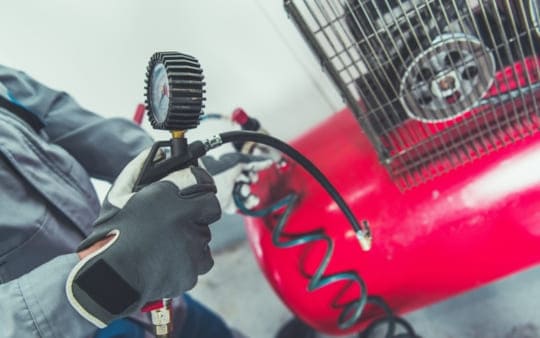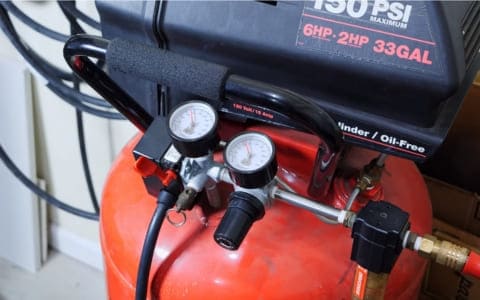When it comes to optimizing your air compressor’s efficiency, increasing CFM is an important aspect. Whether you’re a DIY enthusiast, an electrician, or just someone with a growing need for compressed air, understanding how to increase CFM on an air compressor can make a significant difference.
A higher CFM rating signifies that your compressor can produce more air, leading to an overall enhancement in its performance. In this article, we’ll delve into practical steps and tips to help you boost CFM and get the most out of your air compressor.

Table of Contents
- What is CFM in compressor?
- How to Increase Air Compressor CFM Comparison Method
- How Can You Get More CFM from An Air Compressor?
- Decreasing the Pressure to Increase CFM
- Connect Two Compressors
- Use Another Storage Tank
- Increasing the Size of the Existing Compressor
- Tips On high cfm air compressor
- Choosing the Right Compressor:
- Efficient Air Filtration:
- Appropriate Piping Size:
- Optimizing Pressure:
- Routine Maintenance:
- Cooling System Maintenance:
- Efficient Air Intake:
- Consider Advanced Technologies:
- Operator Guidelines:
- Implement Monitoring Systems:
- How can I make my air compressor more efficient?
- What are the best compressor settings?
- How to calculate the CFM of a compressor?
- Steps:
- How to Reduce CFM on your Air Compressor?
- Conclusion:
- FAQS
- What is a good cfm for air compressor?
- What causes a weak compressor?
- Martina Hitchcock
What is CFM in compressor?
CFM, or Cubic Feet per Minute, measures the volume of air or gas flowing through a specific point in one minute. In the realm of air compressors, CFM is an important factor, denoting the machine’s capability to generate a specific volume of compressed air per minute under a given pressure.
The importance of CFM lies in its role in selecting an appropriate air compressor. Different tools and tasks may demand varying levels of airflow for optimal functionality. Therefore, understanding the CFM rating helps match the compressor to the specific requirements of different applications. CFM serves as a numerical indicator of an air compressor’s capacity to handle air, directly influencing its suitability for various tasks.
How to Increase Air Compressor CFM Comparison Method
| Method | Difficulty | Additional Components Required | Suitable for Continuous (C) or Intermittent (I) Use |
|---|---|---|---|
| Decreasing Pressure to Increase CFM | Low | No | Continuous (C) |
| Adding Another Compressor of Similar CFM | High | Yes | C & I |
| Connecting Two Compressors of Varying CFMs | High | Yes | I |
| Install extra Air Tank | Medium | Yes | C & I |
| Increasing the Size of Existing Compressor | Medium | Yes | C & I |
How Can You Get More CFM from An Air Compressor?
Understanding how airflow functions in your compressor is key to enhancing CFM output. Here are the effective methods to increase CFM on an air compressor:
Decreasing the Pressure to Increase CFM
The amount of air a compressor delivers, measured in cubic feet per minute (CFM), is closely tied to the pressure it operates at, measured in pounds per square inch (PSI). Compressors aren’t just rated for a standalone “CFM” value; it’s a combination like “100 CFM at 100 PSI.” If you reduce the pressure, less CFM is needed, and if you increase pressure, more CFM is required. This relationship varies based on the compressor type.
In a variable speed drive compressor, there is an inverse correlation between CFM and PSI. Raising pressure decreases available CFM, and lowering pressure increases it. Fixed-speed compressors maintain constant air production, so CFM changes aren’t possible without adjusting horsepower. Adjusting pressure affects energy consumption.
To boost CFM, a simple method is reducing compressor operating pressure. Lower pressure increases CFM output, but tool requirements must still be met. The power of a compressor’s pump, measured in horsepower (HP), is constant. Power equals pressure multiplied by CFM. While power can’t be altered, reducing pressure increases CFM, offering adjustment opportunities based on tool requirements and operating pressure.
Connect Two Compressors

To enhance airflow at your tools, you can connect two air compressors in parallel. This involves linking their discharge hoses through a tee fitting, potentially using a wye fitting for better efficiency. By combining the airflow of two compressors with the same output at the same pressure, you can theoretically double the airflow. Keep in mind that actual tool airflow might be slightly lower due to system losses.
Alternatively, you can connect two compressors by merging their air hoses into a single manifold. This method effectively combines the CFM of both compressors, boosting overall airflow.
When it’s not feasible to add another compressor with the same CFM, connecting two compressors with complementary CFM outputs provides a solution. This method enables you to combine the strengths of each compressor to achieve a total CFM that aligns with your requirements, optimizing the overall airflow output.
Use Another Storage Tank
Integrating an additional air receiver tank into your system proves to be an effective strategy for increasing CFM. The receiver tank serves as a reserve, storing compressed air to meet demands during high-use periods.
When the compressor’s CFM output falls short of demand, the stored air from the receiver tank supplements the airflow, ensuring a consistent and uninterrupted supply. Enhancing CFM capacity is possible by adding a larger receiver tank or incorporating multiple tanks into your air compressor system.
Another approach, building on the concept of reducing regulator pressure mentioned earlier, involves using an auxiliary storage tank. Lowering the outlet pressure, as discussed earlier, allows for sustained airflow over an extended period. The auxiliary storage tank, being larger than the compressor alone, ensures a slower pressure drop during tool use. While it’s not feasible to maintain the target CFM as pressure drops, the compressor will cycle to replenish the tank, enabling prolonged tool usage.
Increasing the Size of the Existing Compressor
Expanding your current compressor by getting a larger one with higher CFM can boost performance. Consider factors like power needs and space before upgrading. These improvements help your compressor handle tougher tasks and a wider range of tools. Also, increasing the pump size is an effective way to continuously raise CFM.
Note that increasing motor size may not boost CFM. Retrofitting a new pump and motor may be cost-effective, but sometimes buying a new, higher CFM compressor is more economical. Research thoroughly before making changes to ensure your compressor can handle them well.
Tips On high cfm air compressor

Choosing the Right Compressor:
- Select a compressor with a higher horsepower rating, as this directly impacts CFM.
- Consider the compressor type—rotary screw compressors often provide higher CFM compared to reciprocating ones.
Efficient Air Filtration:
- Keep air filters clean or replace them regularly to maintain optimal airflow.
- Use high-quality filters specifically designed for your compressor model to prevent clogs and restrictions.
Appropriate Piping Size:
- Install piping that matches or exceeds the CFM capacity of your compressor.
- Minimize the use of elbows and turns in the piping system to reduce air resistance.
Optimizing Pressure:
- Adjust pressure settings to match the actual requirements of your tools or equipment.
- Note that higher pressure doesn’t necessarily mean higher CFM; finding the right balance is crucial.
Routine Maintenance:
- Inspect the air system for leaks, as they can significantly impact CFM.
Cooling System Maintenance:
- Make sure the cooling system is operating efficiently to prevent overheating issues.
- Regularly clean cooling fins and ensure proper ventilation to avoid performance issues.
Efficient Air Intake:
- Place the compressor in a clean, well-ventilated area to optimize air intake.
- Regularly check for obstructions like dust or debris that can reduce CFM.
Consider Advanced Technologies:
- Explore variable speed drive (VSD) compressors for automatic output adjustment based on demand.
- VSD compressors are energy-efficient and can maintain a consistent CFM under varying workloads.
Operator Guidelines:
- Educate operators on the correct use of compressed air tools to avoid unnecessary strain on the compressor.
- Encourage the use of high-efficiency tools that require less CFM without compromising performance.
Implement Monitoring Systems:
- Use monitoring systems to track compressor performance and identify potential issues.
- Utilize analytics to optimize settings and ensure the compressor operates at peak efficiency.
How can I make my air compressor more efficient?
I am sharing my experience regarding testing and tweaking high-flow fittings to supercharge an air compressor’s performance.

In the initial setup, I had two couplers and regular air fittings, creating a bit of a mess. The objective was to improve the system by optimizing airflow and efficiency. The first step was removing one coupler and replacing the regular air fitting with a drilled-out straight pipe.
In the tests, we measured the time it took for the air pressure to drop from 140 to 120 PSI at 100 PSI setting. The baseline with the stock, unmodified fitting took 11 seconds.
Next, I introduced a modified version with a drilled-out straight pipe and got it down to 8 seconds. Then, I compared this with an aftermarket high-flow fitting, which also clocked in at 8 seconds. So far, it seemed like reducing couplers and increasing airflow made a significant difference.
But I didn’t stop there. I realized I could further improve the setup by getting rid of all couplers. I purchased a 90-degree fitting but found it too restrictive. Opting for two 45-degree fittings provided a smoother, larger radius, promoting better airflow.
Now, here’s where things got interesting. With this modified setup, the time dropped to 6 seconds, showcasing a substantial improvement. The conclusion? To maximize your air compressor’s performance, reduce couplers, drill out fittings for high flow, and use high-flow fittings wherever possible.
If you’re not into welding, the two 45-degree fittings connected to male connectors can achieve similar results. Ensure complete sealing using Teflon tape.
In a nutshell, upgrading your air compressor doesn’t have to be complicated. With a few DIY tweaks, you can experience a significant boost in performance.
What are the best compressor settings?
| Setting | Description |
|---|---|
| Threshold | Determines when compression begins. Set to capture peaks. |
| Ratio | Governs the extent of compression applied to the audio signal. |
| Attack | Modifies the speed at which the compressor reacts to peak signals. |
| Release | Sets the time it takes for compression to stop. |
| Knee | Determines the onset of compression, gradual or abrupt. |
| Makeup Gain | Compensates for any volume reduction caused by compression. |
How to calculate the CFM of a compressor?
Here are the steps to calculate the CFM of an air compressor;
Steps:
Determine Displacement:
- Identify the compressor’s displacement volume, usually given in cubic inches or cubic centimeters. This represents the volume the compressor moves in one rotation.
Identify Pressure:
- Find the operating pressure of the compressor in PSI.
Evaluate Compression Efficiency:
- Compression efficiency accounts for losses due to heat and other factors. It’s often represented as a percentage. If this detail is not provided, you can use a standard efficiency value (e.g., around 90-95% for rotary screw compressors).
Apply the Formula:
- CFM= Displacement×Pressure / Compression Efficiency
Example:
- Displacement = 100 cubic inches
- Pressure = 150 PSI
- Compression Efficiency = 90%
CFM=100×1500.90CFM=0.90100×150
You can read more for your specific model.
How to Reduce CFM on your Air Compressor?
Reducing the airflow on your air compressor is vital for pneumatic tools with lower airflow needs, preventing damage and extending tool life. Three methods to achieve this are adjusting outlet pressure, using a smaller hose, and decoupling secondary compressors or tanks. Increasing outlet pressure narrows the pressure difference, decreasing airflow. Employing a smaller hose adds pressure drop, limiting outlet airflow. Decoupling secondary compressors or tanks involves attaching a second tool or bleed, effectively reducing airflow, albeit at the cost of wasted compressed air.
It’s crucial to strike a balance when decreasing CFM to ensure tools receive sufficient airflow without impeding their operation. Drastically lowering CFM can slow air transmission into the tank, leading to potential tool malfunctions. If unsure about the adjustment process, seeking professional assistance at a repair shop is advisable to prevent operational issues and maintain the proper functioning of your air compressor.
Conclusion:
By incorporating these strategies, you can significantly enhance the CFM of your air compressor, leading to increased productivity and cost savings. Regular maintenance, proper sizing, and the adoption of advanced technologies will contribute to a more efficient and reliable compressed air system for your operations. Happy compressing!
FAQS
What is a good cfm for air compressor?
Choose the right air compressor by assessing your needs. Household tools may require 4-6 CFM, while industrial applications may need 10 CFM or more. Focus on CFM, not just physical size, with air compressors ranging from 10 to 110 CFM for tools.
What causes a weak compressor?
A weak compressor can result from issues such as air or refrigerant leakage, worn piston rings or seals, low refrigerant levels, faulty valves, electrical problems, excessive heat, inadequate lubrication, incorrect sizing, aging, and contaminants. These factors can compromise the compressor’s efficiency and lead to reduced compression. Timely inspection and maintenance by a qualified technician are crucial to address and resolve these issues, ensuring optimal compressor performance.

Martina Hitchcock
Martina Hitchcock is a versatile author with expertise in different fields. As a paint sprayer expert, she has in-depth knowledge of paint spraying techniques, tools, and equipment. Martina is also an experienced home remodeler who has worked on various projects, including kitchen and bathroom renovations, flooring installations, and room additions. Her knowledge of home improvement and remodeling is extensive, and she enjoys sharing her insights and tips with readers. You can follow her on Facebook.


